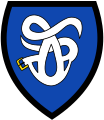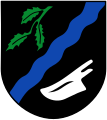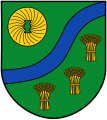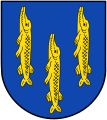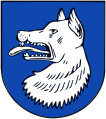List of coats of arms in the Recklinghausen district
This list contains all coats of arms of the Recklinghausen district in North Rhine-Westphalia listed in Wikipedia , including historical coats of arms. All cities, communities and districts in North Rhine-Westphalia have a coat of arms. They can be reached via the navigation bar at the end of the page.
Recklinghausen district
Coat of arms of the Recklinghausen district
The Recklinghausen district in North Rhine-Westphalia
Coat of arms of the cities
Coats of arms of the districts
Castrop-Rauxel
Dates
Dorsten
Haltern am See
Herten
Previous positions
Office dates ( details )
Office Marl ( details )
Blazons and Notes
-
↑ Recklinghausen: "The coat of arms consists of a silver nettle leaf on green shield and a black isosceles cross with a golden key in the middle."
(§ 2 para 2 of the. Main statutes (PDF, 21 kB) of the circle Recklinghausen, approved on 30 June 1952) -
↑ Castrop-Rauxel: "The coat of arms of the city of Castrop-Rauxel consists of a blue shield with a gold St. Andrew's cross in the form of a double crosshair, with the right bar above the left."
(§ 2, paragraph 1 of the main statute of the city of Castrop -Rauxel (PDF; 76 kB), approved by the RP Arnsberg on January 28, 1911, continued by the new town of Castrop-Rauxel with the approval of the Prussian State Ministry on November 24, 1926, after a resolution of the City Council of July 15, 1965 without Wall crown continued.) -
↑ Dates: “Split by black and silver; A ring at the front, a cross in mixed up colors at the back. "
( Website of the city of Datteln ( Memento of the original from March 23, 2012 in the Internet Archive ) Info: The archive link has been inserted automatically and has not yet been checked. Please check the original and archive link accordingly Instructions and then remove this note. , Approved by decree of the Prussian State Ministry of December 20, 1928) -
↑ Dorsten: “The coat of arms shows a continuous black cross on a silver shield, covered with an upright golden key with the beard turned to the left.”
(Section 2, Paragraph 2 of the main statutes of the city of Dorsten ( page no longer available , search in Web archives ) Info: The link was automatically marked as defective. Please check the link according to the instructions and then remove this notice. ) -
↑ Gladbeck: “Shield split; in front in black the gold miner's hammers, behind in gold three 2: 1 set wolf rods. The top of the wall is vermilion. "
(§ 2 Paragraph 1 of the main statute of the city of Gladbeck ( page no longer available , search in web archives ) Info: The link was automatically marked as defective. Please check the link according to the instructions and then remove this notice. , approved by decree of the Prussian State Ministry of September 17, 1929) -
↑ Haltern am See: “A twisted silver halter with a golden buckle on a blue sign.”
(Section 2, Paragraph 1 of the main statute of the city of Haltern am See ( page no longer available , search in web archives ) Info: The link was automatically marked as defective Please check the link according to the instructions and then remove this note. (PDF; 533 kB) from December 16, 2002, continuation approved by a certificate from the Münster District President of November 5, 1975) -
↑ Herten: “The coat of arms is divided and split at the bottom. It shows above in green a lying eight-ended white antlers open to the right, below right a five-petalled red rose in white. It is nested six times in black and white at the bottom left. "
(§ 2 Paragraph 1 of the main statute of the city of Herten ( page no longer available , search in web archives ) Info: The link was automatically marked as defective. Please check the link according to the instructions and remove it then this note. of February 20, 2008, approved by the District President Münster 1976) -
↑ Marl: “The Marl city coat of arms shows a divided shield: the upper field is covered with a black cross, the lower field is divided into silver and black; in the lower right field (seen from the person carrying the sign) there is a black staple, the left field shows - in the form of a St. Andrew's cross - a silver hammer and a silver mallet. "
(Section 1, Paragraph 1 of the main statute of the city of Marl ( PDF; 55 kB), approved by decree of the Upper President of the Province of Westphalia in 1936) -
↑ Oer-Erkenschwick: "Divided by a diagonal right-hand bar divided into blue and silver, the upper field in gold is covered with black mallets and iron, the lower field in black with a golden oak leaf."
(Section 2, Paragraph 1 of the main statute of the city of Oer-Erkenschwick (PDF; 124 kB), approved by decree of the Upper President of the Province of Westphalia on September 7, 1937) -
↑ Recklinghausen: “Semicircular shield on a green background, inside in gold: Rising ring wall, front in the middle with an open arched and roofed portal, inside a standing key turned (heraldically) to the right. Above the curtain wall: Stadtabbreviatur with a windowed, pointed central tower ending in a cross, flanked by two windowed, hooded towers. On the sign: okker-colored crown made of a two-tier battlement wall and three windowed towers of equal height, in the middle with a closed round arched gate in gold. ”
( Website of the city of Recklinghausen ( Memento of the original from June 14, 2008 in the Internet Archive ) Info: The archive link was automatically inserted and not yet checked. Please check the original and archive link according to the instructions and then remove this note. , approved by the Prussian King on June 3, 1908) -
↑ Waltrop: "In golden shields a black, red-armored eagle, covered with a heart shield, which shows a shortened golden tip in a black field."
(Section 2, Paragraph 1 of the main statute of the city of Waltrop ( page no longer available , search in web archives ) Info: The link was automatically marked as defective. Please check the link according to the instructions and then remove this notice. , Approved by decree of the Oberpräsident der Westfalen Province of September 12, 1938) -
↑ Henrichenburg: “On a silver (white) background a slanted black bar, on it three golden (yellow) diamonds. A boat in each of the silver fields. ”
( History of Henrichenburg Castle ( page no longer available , search in web archives ) Info: The link was automatically marked as defective. Please check the link according to the instructions and then remove this notice. The coat of arms of the community Henrichenburg developed from the family coat of arms of the von Düngelen (lords of the castle). The two ships represent the upper and lower water of the Dortmund-Ems Canal.) -
↑ Ahsen: "The coat of arms, a shield divided into blue and silver, shows two silver wavy bars in the upper field and three large black stakes in the lower field."
( Stadtmagazin der Stadt Datteln Since 1939, Ahsen has carried the coat of arms in which lip and canal over three piles of those from Ahusen with headquarters on the Schulte-Ahsen farm are shown.) -
↑ Horneburg: "The coat of arms of the former municipality of Horneburg shows on a red shield with a silver (white) five-pinned castle tower with a red arrow slit, covered in the base of the shield with a red shield with a silver (white) horn pointing to the left with the mouthpiece. The lines in the wall are black. "
( Horneburg on www.ngw.nl ) -
↑ Altendorf-Ulfkotte: "On a black background divided by a slanted blue wavy bar in the upper field a three-leaved green ilex twig and a silver (white) ploughshare below."
( Districts of the city of Dorsten ( Memento of the original from December 24, 2011 in the Internet Archive ) Info: The archive link was inserted automatically and not yet checked. Please check the original and archive link according to the instructions and then remove this note. The coat of arms - a silver ploughshare (for agriculture) with a pod crab (Ilex) (typical for the landscape) was created in 1987 designed, the diagonal wavy bar symbolizes the Erdbach, which separated the original settlements Altendorpe and Huselar.) -
↑ Interpret: "On a green background divided by a slanted blue wavy bar in the upper field a golden (yellow) millstone and below three golden (yellow) sheaves of grain."
( Districts of the city of Dorsten ( Memento of the original from December 24, 2011 in the Internet Archive ) Info: The archive link was inserted automatically and has not yet been checked. Please check the original and archive link according to the instructions and then remove this notice. The blue wavy bar indicates the location of the location on the Rhader Mühlenbach. The green and the grain stacks represent agriculture and the Millstone for Tüshaus Mühle, which is maintained today as a technical cultural monument.) -
↑ Hervest: “Three vertically standing golden (yellow) pikes on a blue shield; the middle one is slightly offset from the foot of the shield. ”
( Districts of the city of Dorsten ( Memento of the original from December 24, 2011 in the Internet Archive ) Info: The archive link has been inserted automatically and has not yet been checked. Please check the original and archive link according to the instructions and then remove it Note: The coat of arms originally comes from the von Vorteilst family, which died out around 1400.) -
↑ Holsterhausen: "On a red background divided by two golden (yellow) wavy bars, two in the shield head and a golden (yellow) ring in the shield base."
( Districts of the city of Dorsten ( Memento of the original from December 24, 2011 in the Internet Archive ) Info: The archive link was inserted automatically and has not yet been checked. Please check the original and archive link according to the instructions and then remove this notice. The coat of arms has been used in this form since 1935 and comes from the von Hagenbeck family (without corrugated bars). The corrugated bars (symbolize lip and Wesel-Datteln Canal) were added in 1935.) -
↑ Lembeck: "A silver (white) nettle leaf on a red shield."
( Stadtteile der Stadt Dorsten ( Memento of the original from December 24, 2011 in the Internet Archive ) Info: The archive link has been inserted automatically and has not yet been checked. Please check the original and Archive link according to instructions and then remove this note. The coat of arms of the municipality was taken over by the Lords of Lembeck; it is passed down by a seal from 1254.) -
↑ Rhade: "A black tree stump on a blue and gold (yellow) divided sign."
( City districts of the city of Dorsten ( Memento of the original dated December 24, 2011 in the Internet Archive ) Info: The archive link was automatically inserted and not yet checked. Please check Original and archive link according to the instructions and then remove this note. The coat of arms reminds of the clearing before the place was founded - it is a so-called "talking coat of arms".) -
↑ Wulfen: "A silver (white) wolf's head on a blue sign."
( Districts of the city of Dorsten ( Memento of the original from December 24, 2011 in the Internet Archive ) Info: The archive link was inserted automatically and has not yet been checked. Please check the original and Archive link according to the instructions and then remove this note. The Wulfen coat of arms goes back to the symbols of the Knights of Wulfheim.) -
↑ Flaesheim: "The coat of arms, a shield divided into blue and silver, shows two silver wavy bars in the upper field, three red rafters in the lower field."
( Flaesheimer Heimatverein Die Wellenbalken indicate the watercourses that cut through or touch the municipality of Flaesheim - Wesel Datteln Canal and Lippe. In 1939 Flaesheim was given the right to use its own coat of arms by a decree of 14 June by the President of the Province of Westphalia.) -
↑ Lippramsdorf: "Divided by gold (yellow) and blue in a wave cut diagonally to the right, above below the middle a blue-yellow bar in alternating colors also divided in a wave cut"
( Heimatverein Lippramsdorf The wave line indicates the location of the place on the Lippe. The blue stands for belonging to the town of Haltern am See and the gold (yellow) for the sandy soils of the area.) -
↑ Alt-Herten: "On a divided sign above in green a lying eight-ended silver (white) antlers open to the right, below in silver (white) three five-petalled red roses in a ratio of 2: 1."
( Herten city history ( page no longer available , Search in web archives ) Info: The link was automatically marked as defective. Please check the link according to the instructions and then remove this notice. In connection with the granting of city rights, the right to use your own city arms was granted on June 8, 1936 The coat of arms is based on the coat of arms of the Lords of Herten, who had lived there since the 13th century.) -
↑ Westerholt: "The shield is quartered, it contains in the upper right and lower left fields, the coat of arms of the Lords of Westerholt:" Split in black and silver (white) and divided three times. " The remaining silver (white) fields are covered with hammer and iron. ”
( Heimatverein Westerholt ( Memento of the original from January 23, 2013 in the Internet Archive ) Info: The archive link was inserted automatically and not yet checked. Please check the original and archive link accordingly Instructions and then remove this note In 1937, Westerholt was granted the right to use its own coat of arms by the decree of the Upper President of the Province of Westphalia of May 8. The coat of arms is based on the coat of arms of the Lords of Westerholt, who had been in existence since the 13th century were resident there.)
Web links
- Brochure Well armed for the Recklinghausen district (PDF file; 838 kB)






